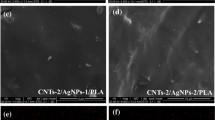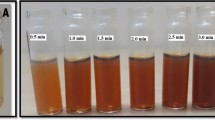Abstract
This work aims to prepare nanosilver coated carbon black via benzoxazine oxidation as a filler for polylactic acid (PLA) to produce novel hybrid materials with improved electrical and antimicrobial properties. Nanosilver coated carbon black exhibited antimicrobial activity against S.aureus, B.subtilis, M.luteus, E.coli, P.aeruginosa and C.albicans. It was found that the nanosilver coated carbon black (10CB-Ag) was the most effective filler since it showed largest inhibition zones. Thermogravimetric analysis (TGA) showed that the silver content in 10CB-Ag was 5.68% by weight. The hybrid materials of PLA with uncoated carbon black and nanosilver coated carbon black fillers were prepared by injection molding. The optimal composition of the prepared hybrid materials was found to be 15 phr of nanosilver coated carbon black in PLA (15AgCB-PLA). This material showed quite good properties, e.g. tensile strength of 50 MPa, % elongation at break of 1.68 and electrical conductivity of 2.78 × 10−9 S⋅m−1. Moreover, it exhibited the S. aureus inhibition of about 99%. This work revealed the possibility of using this material for anti-electrostatic and antimicrobial applications.








Similar content being viewed by others
References
Jambeck JR, Geyer R, Wilcox C, Siegler TR, Perryman M, Andrady A, Narayan R, Law KL (2015) Plastic waste inputs from land into the ocean. Science 347(6223):768–771. https://doi.org/10.1126/science.1260352
Derraik JGB (2002) The pollution of the marine environment by plastic debris: A review. Mar Pollut Bull 44(9):842–852. https://doi.org/10.1016/S0025-326X(02)00220-5
Al-Salem SM, Lettieri P, Baeyens J (2009) Recycling and recovery routes of plastic solid waste (PSW): A review. Waste Manag 29(10):2625–2643. https://doi.org/10.1016/j.wasman.2009.06.004
Ren X (2002) Biodegradable plastics: A solution or a challenge? J Clean Prod 11(1):27–40. https://doi.org/10.1016/S0959-6526(02)00020-3
Liu N, Chen X-G, Park H-J, Liu C-G, Liu C-S, Meng X-H, Yu L-J (2006) Effect of MW and concentration of chitosan on antibacterial activity of Escherichia coli. Carbohydr Polym 64(1):60–65. https://doi.org/10.1016/j.carbpol.2005.10.028
Rinaudo M (2006) Chitin and chitosan: Properties and applications. Progress in Polymer Science (Oxford) 31(7):603–632. https://doi.org/10.1016/j.progpolymsci.2006.06.001
Haafiz MKM, Hassan A, Zakaria Z, Inuwa IM, Islam MS, Jawaid M (2013) Properties of polylactic acid composites reinforced with oil palm biomass microcrystalline cellulose. Carbohydr Polym 98(1):139–145. https://doi.org/10.1016/j.carbpol.2013.05.069
González-García DM, Téllez Jurado L, Jiménez-Gallegos R, Rodríguez-Lorenzo LM (2017) Novel non-cytotoxic, bioactive and biodegradable hybrid materials based on polyurethanes/TiO2 for biomedical applications. Mater Sci Eng C 75:375–384. https://doi.org/10.1016/j.msec.2017.02.041
Pan Y, Liu X, Kaschta J, Hao X, Liu C, Schubert DW (2017) Viscoelastic and electrical behavior of poly(methyl methacrylate)/carbon black composites prior to and after annealing. Polymer (United Kingdom) 113:34–38. https://doi.org/10.1016/j.polymer.2017.02.050
Mao GX, Zhu AF (2012) Enhanced Electrically Conductive Polypropylene/Nano Carbon Black Composite. Polym-Plast Technol Eng 51(10):1073–1076. https://doi.org/10.1080/03602559.2012.679380
Ma L-F, Bao R-Y, Huang S-L, Liu Z-Y, Yang W, Xie B-H, Yang M-B (2013) Electrical properties and morphology of carbon black filled PP/EPDM blends: Effect of selective distribution of fillers induced by dynamic vulcanization. J Mater Sci 48(14):4942–4951. https://doi.org/10.1007/s10853-013-7275-z
Chen X, Schluesener HJ (2008) Nanosilver: A nanoproduct in medical application. Toxicol Lett 176(1):1–12. https://doi.org/10.1016/j.toxlet.2007.10.004
Morones JR, Elechiguerra JL, Camacho A, Holt K, Kouri JB, Ramírez JT, Yacaman MJ (2005) The bactericidal effect of silver nanoparticles. Nanotechnology 16(10):2346–2353. https://doi.org/10.1088/0957-4484/16/10/059
Choi O, Deng KK, Kim N-J, Ross Jr L, Surampalli RY, Hu Z (2008) The inhibitory effects of silver nanoparticles, silver ions, and silver chloride colloids on microbial growth. Water Res 42(12):3066–3074. https://doi.org/10.1016/j.watres.2008.02.021
Kaewvilai A, Wattanathana W, Jongrungruangchok S, Veranitisagul C, Koonsaeng N, Laobuthee A (2015) 3,4-Dihydro-1,3-2H-benzoxazines: Novel reducing agents through one electron donation mechanism and their application as the formation of nano-metallic silver coating. Mater Chem Phys 167:9–13. https://doi.org/10.1016/j.matchemphys.2015.10.011
Wattanathana W, Nonthaglin S, Veranitisagul C, Koonsaeng N, Laobuthee A (2014) Crystal structure and novel solid-state fluorescence behavior of the model benzoxazine monomer: 3,4-Dihydro-3,6-dimethyl-1,3,2H-benzoxazine. J Mol Struct 1074:118–125. https://doi.org/10.1016/j.molstruc.2014.05.057
Kaewvilai A, Rujitanapanich S, Wattanathana W, Veranitisagul C, Suramitr S, Koonsaeng N, Laobuthee A (2012) The effect of alkali and ce(III) ions on the response properties of benzoxazine supramolecules prepared via molecular assembly. Molecules 17(1):511–526. https://doi.org/10.3390/molecules17010511
Reimer, L.G. Antibiotics in laboratory medicine. Lorian V, editor. Baltimore: Williams and Wilkins, 2nd ed, 1986
Olyveira GMD, Costa LMM, Carvalho AJFD, Basmaji P, Pessan LA (2011) Novel LDPE/EVA nanocomposites with silver/titanium dioxide particles for biomedical applications. J Mater Sci Eng B 1:516–522
ASTM (2004) Standard test method for determining the antimicrobial activity of immobilized antimicrobial agents under dynamic contact conditions: E2149-10. Annual Book of American Standard Testing Methods. ASTM, Philadelphia
Jenkins R (2008) X-Ray Fluorescence Spectrometry. Handb Anal Tech 2-2:753–766. https://doi.org/10.1002/9783527618323.ch23
Sanchez-Garcia MD, Lagaron JM (2010) On the use of plant cellulose nanowhiskers to enhance the barrier properties of polylactic acid. Cellulose 17(5):987–1004. https://doi.org/10.1007/s10570-010-9430-x
Torres A, Ilabaca E, Rojas A, Rodríguez F, Galotto MJ, Guarda A, Villegas C, Romero J (2017) Effect of processing conditions on the physical, chemical and transport properties of polylactic acid films containing thymol incorporated by supercritical impregnation. Eur Polym J 89:195–210. https://doi.org/10.1016/j.eurpolymj.2017.01.019
Chen C, Gu X, Jin X, Sun J, Zhang S (2017) The effect of chitosan on the flammability and thermal stability of polylactic acid/ammonium polyphosphate biocomposites. Carbohydr Polym 157:1586–1593. https://doi.org/10.1016/j.carbpol.2016.11.035
Sung SH, Chang Y, Han J (2017) Development of polylactic acid nanocomposite films reinforced with cellulose nanocrystals derived from coffee silverskin. Carbohydr Polym 169:495–503. https://doi.org/10.1016/j.carbpol.2017.04.037
Chen P-Y, Lian H-Y, Shih Y-F, Chen-Wei S-M, Jeng R-J (2017) Preparation, characterization and crystallization kinetics of Kenaf fiber/multi-walled carbon nanotube/polylactic acid (PLA) green composites. Mater Chem Phys 196:249–255. https://doi.org/10.1016/j.matchemphys.2017.05.006
Tábi T, Sajó IE, Szabó F, Luyt AS, Kovács JG (2010) Crystalline structure of annealed polylactic acid and its relation to processing. Express Polym Lett 4(10):659–668. https://doi.org/10.3144/expresspolymlett.2010.80
Acknowledgements
The authors would like to acknowledge the financial support from the National Research Council of Thailand (NRCT) and Kasetsart University Research and Development Institute (KURDI). Appreciation is also expressed Department of Materials Engineering, Faculty of Engineering, Kasetsart University and Department of Chemistry, Faculty of Science, Kasetsart University for the support of research facilities.
Author information
Authors and Affiliations
Corresponding author
Rights and permissions
About this article
Cite this article
Nootsuwan, N., Wattanathana, W., Jongrungruangchok, S. et al. Development of novel hybrid materials from polylactic acid and nano-silver coated carbon black with distinct antimicrobial and electrical properties. J Polym Res 25, 90 (2018). https://doi.org/10.1007/s10965-018-1484-8
Received:
Accepted:
Published:
DOI: https://doi.org/10.1007/s10965-018-1484-8




